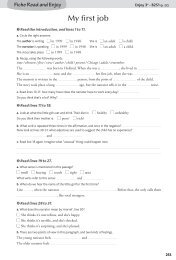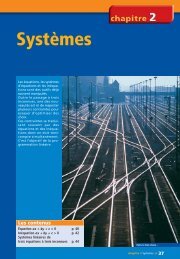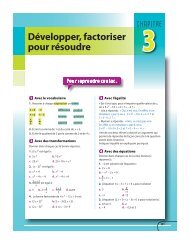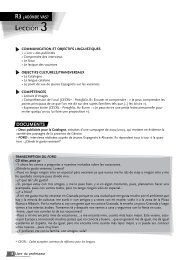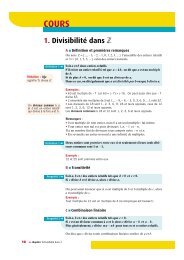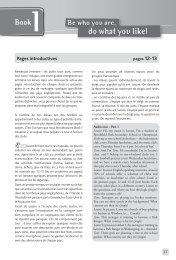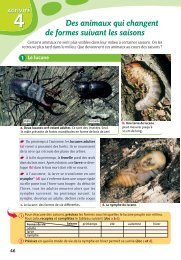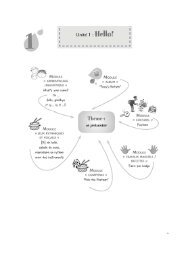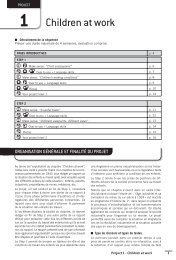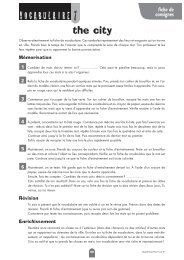Upstairs Downstairs - Didier
Upstairs Downstairs - Didier
Upstairs Downstairs - Didier
Create successful ePaper yourself
Turn your PDF publications into a flip-book with our unique Google optimized e-Paper software.
her servants remained hazy to her: it’s somehow<br />
symptomatic that Woolf always misspelled her<br />
cook’s first name as ‘Nelly’, rather than the actual<br />
Nellie. Even though they were subject to terrible<br />
mental and emotional distress, Woolf dismissed<br />
her servants’ fury or misery as hysterics, as if<br />
sensitivity only kicked in on a certain rung of the<br />
class structure. ‘I am an individual,’ Agnes Smith<br />
reproached her, ‘as unique in my way as you are<br />
in yours.’<br />
Light approaches her subject through Woolf’s most<br />
piercing relationships with her servants. Sophie<br />
Farrell, a country girl ‘brought up in the heartlands<br />
of deference’, was a mainstay of Woolf’s childhood<br />
and remained devoted to her. Lottie Hope, a volatile<br />
foundling child trained up into service, and Nellie<br />
Boxall were the servants of Woolf’s maturity.<br />
Nellie in particular drove her mistress to despair<br />
and vice versa…<br />
Reading Woolf on Nellie and, indeed, on the working<br />
class in general, it’s easy to conclude that she<br />
was a cow to work for (prejudice, Light remarks,<br />
was her default mode, even though she picked at<br />
these prejudices in her fiction). But the Woolfs and<br />
their Bloomsbury pals were, in many ways, enlightened<br />
employers. Uniforms and subservient address<br />
were discarded; the demands of formal entertaining<br />
increasingly abandoned for jolly evenings with<br />
whisky and buns. Both in the domestic and political<br />
arena, Woolf loathed authority – her widower<br />
father’s tyrannical rages remained with her – but<br />
running a household left her in a dilemma. She<br />
wanted the attentions of a servant without having<br />
to wield the authority of a mistress. As Light argues,<br />
it was considered a specifically female situation:<br />
the servant problem scrabbles at gender as well<br />
as class differences…<br />
The Bloomsburies hoped to reshape British<br />
society. But, as Light bluntly states: ‘There could<br />
never be a modernist domesticity with servants<br />
still in tow.’<br />
http://books.guardian.co.uk/reviews/biography/<br />
0,,2141696,00.html#article_continue<br />
[Alison Light] teases out the implications of what<br />
was clearly a complicated relationship of mutual<br />
dependence. No one reading Woolf’s diaries could<br />
fail to be struck by her fraught relationships with<br />
her servants, chiefly the manipulative Nellie Boxall<br />
and the hysterical Lottie Hope. Woolf was extremely<br />
fond of them; she despised them; she needed them<br />
desperately, and as Light demonstrates, this was<br />
absolutely reciprocal.<br />
http://www.independent.<br />
co.uk/arts-entertainment/books/reviews/mrs-woolf-andthe-servants-by-alison-light-462750.html<br />
À noter aussi l’ouvrage Mrs Woolf and the Servants;<br />
the Hidden Heart of Domestic Service (2007) d’Alison<br />
Light.<br />
– Restitution par les élèves de ce qu’ils ont compris seuls<br />
sur les événements (faits et / ou réactions). Phase rapide.<br />
Il ne s’agit pas d’entrer dans les détails mais de dire en<br />
quelques courtes phrases de quoi il s’agit. Il n’y a que<br />
pour la première entrée qu’il faut comprendre que l’écrit<br />
comporte deux parties, délimitées par l’ellipse.<br />
– Les élèves devraient pouvoir dire qu’il manque des<br />
informations. L’objectif est d’élucider ce qui peut l’être<br />
en devinant à partir du contexte. Pour guider davantage<br />
les élèves, on peut mettre le doigt sur certaines informations<br />
précises qui nécessitent des éclaircissements,<br />
comme avec l’exemple que nous avons fourni dans le<br />
manuel. Pour compléter ce type de travail, l’activité 7<br />
p. 59 de la partie Language skills pourra être proposée<br />
à la maison.<br />
3. Phase de bilan et remplissage de la Logpage.<br />
Over to you<br />
4. Transformation d’un témoignage sur un événement<br />
précis en entrée de journal intime. La Logpage permettra<br />
aux élèves de réorganiser le discours. La mise en<br />
commun sur cette activité et celle des Language skills<br />
prendra une séance.<br />
5. Sur http://www.channel4.com/history/microsites/C/<br />
countryhouse/edwardianlife/timeline.html, on trouve<br />
une chronologie détaillée dont on peut retenir les dates<br />
suivantes :<br />
1901<br />
22nd January Death of Queen Victoria, aged 81, after a reign of 63 years. Edward VII succeeds to the<br />
throne.<br />
1903<br />
October Formation of the suffragette Women’s Social and Political Union (WSPU).<br />
1904<br />
April<br />
Entente Cordiale signed with France.<br />
May<br />
Rolls-Royce car manufacturing company formed.<br />
November Figures released reveal that poverty is rising dramatically – 122,000 people in London and<br />
800,000 in England and Wales are in receipt of poor relief, with 250,000 in workhouses.<br />
1910<br />
21st May Death of Edward VII; succeeded by George V.<br />
Project 3 - <strong>Upstairs</strong> <strong>Downstairs</strong><br />
9



